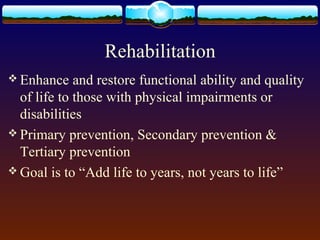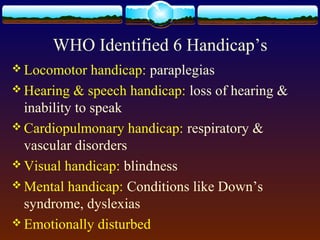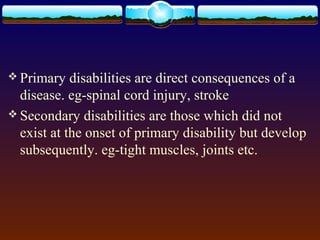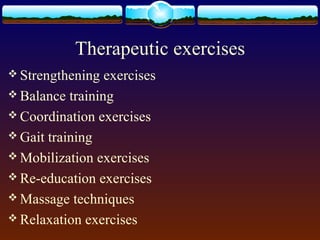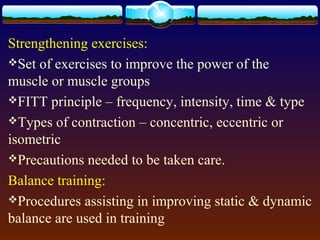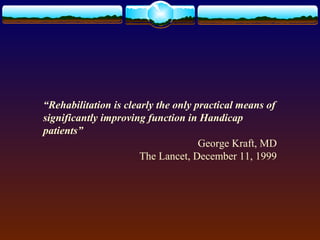Handicap care
- 2. Handicap & Disability Disadvantage for a given individual in his or her social context, that limits or prevents the fulfillment of a role that is normal to an individual. Any restriction or lack of ability to perform an activity in the manner normal to a individual. Physical, cognitive, mental, sensory, emotional or combinations are noted. Disability prevents subjects from being independent. Disabled persons are addressed “Differently Abled” persons.
- 3. Rehabilitation Enhance and restore functional ability and quality of life to those with physical impairments or disabilities Primary prevention, Secondary prevention & Tertiary prevention Goal is to “Add life to years, not years to life”
- 5. WHO Identified 6 Handicap’s Locomotor handicap: paraplegias Hearing & speech handicap: loss of hearing & inability to speak Cardiopulmonary handicap: respiratory & vascular disorders Visual handicap: blindness Mental handicap: Conditions like Down’s syndrome, dyslexias Emotionally disturbed
- 6. Primary disabilities are direct consequences of a disease. eg-spinal cord injury, stroke Secondary disabilities are those which did not exist at the onset of primary disability but develop subsequently. eg-tight muscles, joints etc.
- 7. Result of Decreased Activity due to handicap
- 8. Rehabilitation Team Doctor Physiotherapist Occupationaltherapist Speech pathologist Prosthetist – Orthotist Rehabilitation nurse Psychologist Music or play therapist Biomedical engineer Social worker Vocational counselor Special educator Government agencies
- 10. Delivery of Rehabilitation care Institutional based care (IBR) Homes Day care centers Outpatient clinic Camps Community based rehabilitation (CBR)
- 11. Therapeutic exercises Strengthening exercises Balance training Coordination exercises Gait training Mobilization exercises Re-education exercises Massage techniques Relaxation exercises
- 12. Strengthening exercises: Set of exercises to improve the power of the muscle or muscle groups FITT principle – frequency, intensity, time & type Types of contraction – concentric, eccentric or isometric Precautions needed to be taken care. Balance training: Procedures assisting in improving static & dynamic balance are used in training
- 13. Coordination exercises: For performing precise smooth and purposeful movement using multiple muscles and a stable posture Volition - Ability to start, maintain or stop an activity Perception – intact centers and areas in brain to retrieve the plans stored prior Motor plans in central nervous system Repetitive exercises, precision & attention are important part of treatment
- 14. Gait training: Gait or human locomotion is a translatory progression of the body as a whole, produced by coordinated movements of body segments. Normal gait requires sensory inputs and proper muscular activity. Gait training can be given using assistive devices such as crutches, walkers, sticks etc.
- 15. Mobilization exercises: Mobilization is passive movement in such a manner or speed that the patient can stop the movement at his will. It helps in restoring or maintaining joint movement Massage techniques: Manipulation of soft tissues and assisting in circulation of extremities Assists in treating pathological disorders.
- 16. Relaxation exercises: Relaxation is a state in which the muscles of the body are relatively free from tension General relaxation & Local relaxation Reeducation exercises: Exercises taught to train a lost or new activity to muscle groups after various pathologies. Done in grades to increase the activity subsequently
- 17. Summary Physical Activity/Exercise can improve disability and handicap Improvement in quality of life
- 18. “Rehabilitation is clearly the only practical means of significantly improving function in Handicap patients” George Kraft, MD The Lancet, December 11, 1999
Editor's Notes
- We know from extensive research, mostly from cardiac rehabilitation, that inactivity causes deconditioning and those who are deconditioned tend to be less active. In addition, we know that the inactivity can cause physical impairment and psychological disturbances such as depression and decreased self-esteem. This vicious circle can cause significant problems with overall health and places individuals at greater risk for cardiovascular diseases.


